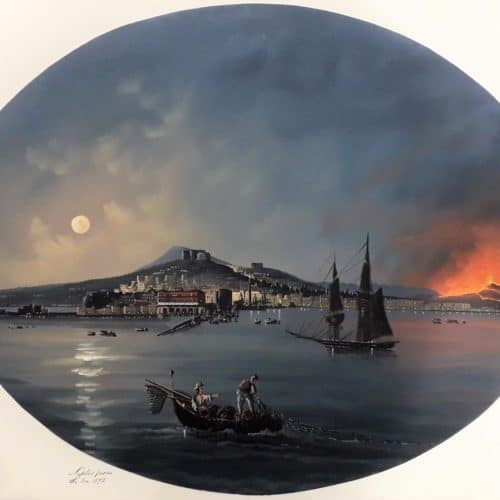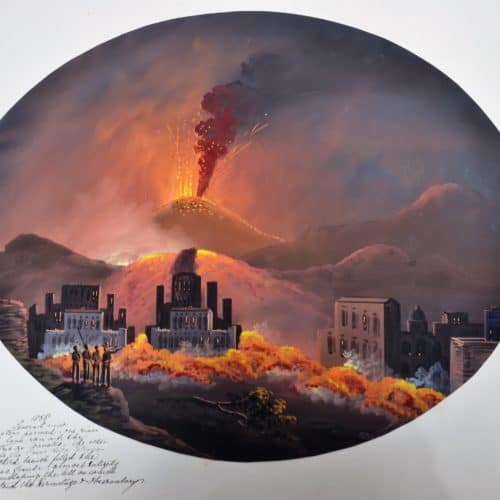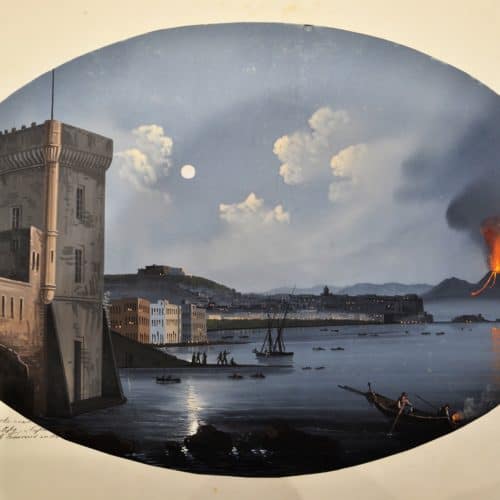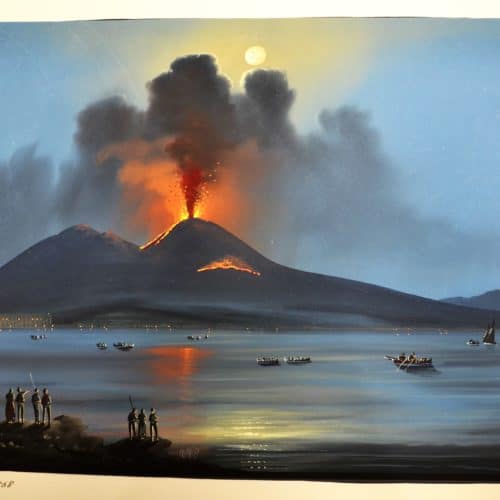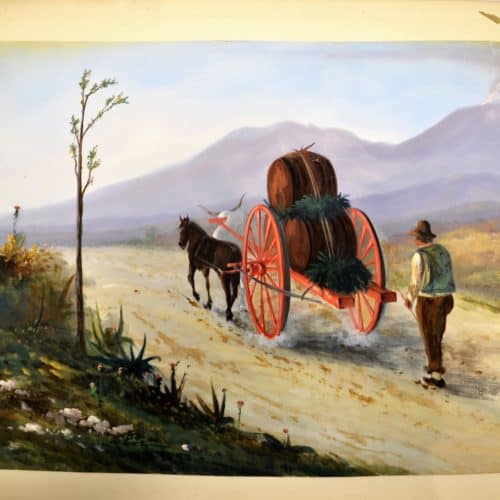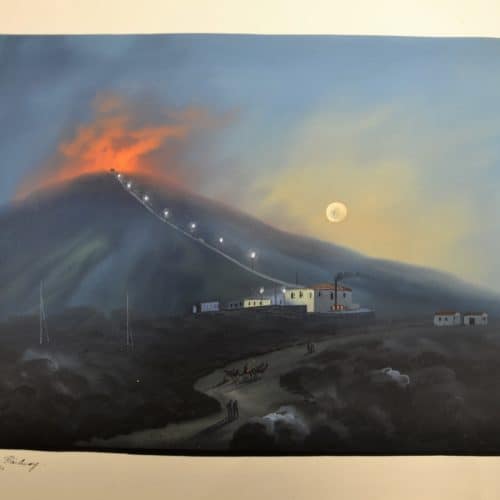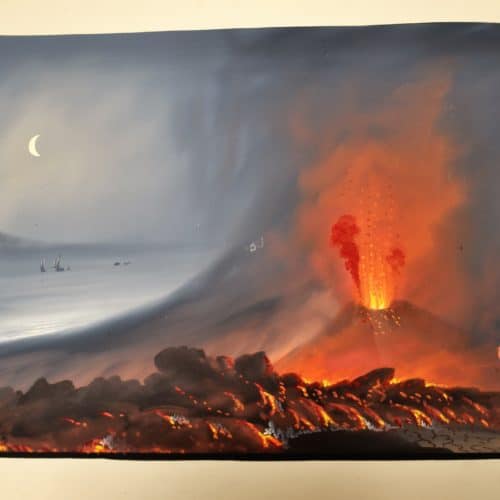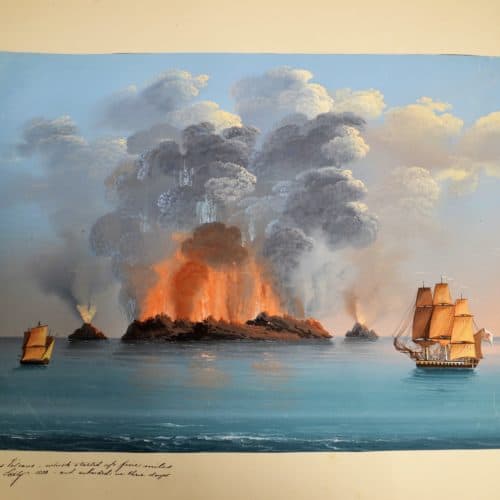Master Collection 18: Vesuvius eruptions
The letter says:
This collection of Drawings in Gouache (chalk & fish glue) by Neapolitan artists was made by the Hon Rose Hubbard between the years 1864-1900- They are absolutely faithful – as regards the Eruptions.
It is dated September 1931.
The black border signified mourning: someone close to the writer had died recently. It was probably written by the Hon. Rose Ellen Hubbard, whose oldest sister, Alice, died in 1931. The handwriting is very similar in information and dates for many of the pictures in the album.
The Hon. Rose Ellen Hubbard (1851-1933) was the granddaughter of William John Napier, 9th Lord Napier (1786-1834). Napier was a Royal Navy officer who fought at the Battle of Trafalgar and was later made Chief Superintendent of Trade at Canton in China. He died there, of typhoid.
Her father, John Hubbard, 1st Baron Addington (1805-1889), a City of London financier and Conservative Party politician who became Governor of the Bank of England. They must have been very wealthy to be able to spend so much time in Italy, and to pay for the expensive leather and gold binding of the Views of Naples album.
Rose lived in Buckinghamshire before moving in about 1909 to Folkestone, where she lived in Baldric Road. According to her obituary, she was at Folkestone Harbour when one of the first boats with Belgian refugees arrived. She became closely involved in helping all the Belgian refugees.
Mrs Amy Master, who gave the album of Naples views to Folkestone Museum, probably knew Rose. We don’t know if it was given to Mrs Master, or she bought it. She would have been aware of its great educational value to Folkestone Museum.
On the right, a volcanic eruption is taking place. Vesuvius, the volcano from which molten rock is pouring, buried Pompeii when it erupted during Roman times in AD79.
The streams of molten rock or ‘lava’ are painted as yellow lines across the mountain.
In the foreground are fishermen, continuing to fish by moonlight.
This eruption in 1872 was classed as a ‘minor’ one. It had begun on 1 January 1871 and continued into 1872, with a lot of volcanic activity in April.
Many tourists came to watch, as seen in the picture dated April 16th 1872. On the night of April 26th 1872 it culminated in the opening of a huge fissure, from which lava flowed. Ash, stones and lava at the same time blasted out of the main cone to a height of 1,500 metres and there was thunderous noise. People who had gone up close to look were badly burnt or killed.
This part of southern Italy is geologically active: tectonic plates below the earth’s crust are moving against one another. The friction causes earthquakes and hot molten rock to rise up as volcanoes.
In this picture we can see a volcano – Vesuvius – erupting in the background. Spurts of molten lave and plumes of hot volcanic ash are being propelled into the air. A lot of red-hot molten lava is covering the hillsides and has inundated the town.
The men in the foreground are observing the lava flow and discussing what to do. One holds a long pole for pushing things out of the way of the lava.
The inscription below the picture dates it to 1858. The Vesuvius eruption in 1858 was classed as a ‘minor’ one, like those of 1871, 1872, 1895-1899, 1900, 1903 and 1904. Major eruptions occurred in 1906, 1929 and 1944. The last one changed the shape of the crater. the inscription says:
‘Several new craters formed,’ ‘One river of land ran into the Atrio di Cavallo, the other into the Fosso della Vetrana. A third branch filled the Fosso Grande, almost entirely enveloping the hill on which stand the Hermitage and Observatory.’
The Hermitage was a travellers’ rest stop on the mountainside of Vesuvius. An Observatory was built next to it in 1841-1845 for study of volcanic activity.
The eruption in May 1858 followed a series of earthquakes accompanied by volcanic activity in December 1857. Thousands of people had died or been made homeless in the earthquakes.
This gouache painting On the Road to Posillipo, Naples, with Vesuvius in 1868 is by an unknown Naples artist.
It looks like evening: it’s getting dark, a full moon is in the sky, and lights are on in the windows of buildings and along the harbour. However, the moon is sometimes visible in daytime, and the volcano is belching out clouds of black ash that would obscure sunlight and create a dark sky. Compare with the view dated March 16th 1868 (below) and see what you think.
The fortress of Castel Sant’Elmo can be seen on top of a hill in the middle. It looks foreboding and was intended to, as it was built to frighten locals!
Look closely. The fisherman in the stern of the small boat in the foreground is pointing a burning torch (a long stick with fire at the end of it) towards the water. This might be to attract a shoal of fish, which are sometimes attracted to light. The artist has included it so that there are three points of orange fire on the right: the volcano, its reflection and the fire in the foreground.
The view is taken from the road out of Naples to Posillipo, past the lighthouse seen in the Harbour view (See Learn with Objects Master 5: fishing). You can orientate yourself by comparing locations of the hilltop fortress.
Posillipo is a hilly piece of land jutting into the Bay of Naples. It is named after a Roman villa.
Fascinating fact
It was here that W. S. Gilbert, one half of the operetta composers Gilbert and Sullivan, was kidnapped and ransomed by brigands in 1839, at the age of two.. This was an incident that he later used in story plots.
This gouache painting is of Mount Vesuvius. It was painted by an unknown Naples artist and dated March 16th 1868.
It looks a bit like evening: the sky is getting dark, there appears to be a full moon, and in the distance on the left, lights are glowing in windows and along the harbour.
However, the volcano is belching out clouds of black ash that would obscure the sky - it looks blue on the right and it may be the sun we can see above.
The ash clouds would make it so dark that lamps had to be lit in daytime.
The sun this morning looked like the moon in a mist wrote an observer of the subsequent eruption in 1872. In the morning it was so dark at 8 o’clock that the lamps were lit.
(The Times, 6 May 1872)
Coming out of the volcano is hot ash, smoke, stones and lava. It is belching out of the cone at the top of the volcano. There is also lava coming out of a crevice in the side of the volcano.
People are looking at the volcanic eruption, either from boats or standing by the sea. Tourists came from afar and many ventured up the volcano itself! Visitors were unwilling to heed the advice of locals, who knew the unpredictability of volcanic activity.
This gouache painting by an unknown Naples artist is titled:
Vesuvius, April 16th 1872, Naples side.
It almost looks like night, as there are lamps lit and it looks dark. In fact it is daytime: the sun is high in the sky but the volcano is belching out smoke and ash, making it dark.
The sun this morning looked like the moon in a mist...
wrote an observer on 27 April. In the morning on 28 April it...
\was so dark at 8 o’clock that the lamps were lit.
(The Times, 6 May 1872)
There appear to be four or five lava flows. In addition to lava spilling from the top cone are flows of lava from crevices lower down the mountain.
People are looking at the volcano from the shore. Many tourists came specially to see the spectacular volcanic activity. Some of them ignored advice and went as far as they could up the mountain.
On the night of 26th April the eruption culminated in the opening of a huge fissure, from which lava flowed. Ash, stones and lava at the same time blasted out of the main cone to a height of 1,500 metres and there was thunderous noise. People who had gone up close to look were badly burnt or killed. Villages were destroyed and damaged, and many local people had to leave with whatever possessions they could carry and seek shelter elsewhere.
This gouache painting by an unknown Naples artist is called Road up Vesuvius
The animals pulling the cart are an ox and a horse. The ox has huge horns.
The barrels probably contain wine destined for the Hermitage, a travellers’ rest stop on the way up Vesuvius. You can see the cone of Vesuvius emitting smoke or ash on the right. Grasses have been used to pad the barrels and keep them firm beneath rope ties.
There only a few thin plants because they are just starting to grow back after an eruption covered the mountainside in lava and ash.
Can you see the dusty ash rising up around the cartwheels and animal’s hooves?
The mountainside is still grey. Among the new growth are brightly coloured flowers. Volcanic soil is very good for growing things.
Local people living in the shadow of Vesuvius knew the volcano was active and could erupt at any time. But they stayed because it such was good land for agriculture.
This gouache painting by an unknown Naples artist shows the Mount Vesuvius Funiculare Railway by Night
From 1880 onwards, instead of climbing Vesuvius by foot, on horseback or in a sedan chair carried by locals, visitors could ascend to the crater by funicular railway. The launch was celebrated in the Neapolitan song, Funiculi, Funicula, performed by many famous singers including opera star Luciano Pavarotti.
The funicular railway is like Folkestone’s Leas Lift (and ones at many other seaside resorts around the UK) but much longer.
There are passenger carriages on a fixed track, that were moved up and down by a pulley. The pulley was powered by the engine house near the roadway.
A huge eruption in 1906 damaged the funicular railway. It was rebuilt, but then it was damaged by another eruption in 1911. It was rebuilt again and survived another eruption in 1929. During the Second World War a huge eruption in 1944 damaged the funicular beyond repair.
The volcano is active in the picture. We can see the orange light of lava in the crater lighting up the gases coming from the cone.
On the road the is a carriage and people walking up to the funicular. The volcano was most spectacular to view at night and the funicular continued to function after dark.
Fascinating fact
The arrival of the funicular railway meant that local guides missed out on the fees they charged to take people up Vesuvius. They burnt the station, cut the track and threw a carriage down the crater.
Thomas Cook bought the funicular company in 1888 and his son negotiated a settlement with the guides: they agreed to pay them tax for every passenger carried. This probably saved money overall and made for better relationships!
The Crater, 1883 is a view from the top of Mount Vesuvius, looking down towards the crater. It is a gouache painting by an unknown Naples artist.
The lumps in the foreground are molten rock or ‘lava’. It is beginning to cool and solidify on the outside but is still hot and glowing on the inside.
Lava could stay hot for a long time: the head of the Vesuvius Observatory reported in May 1872 that he could still see lava from the 1858 eruption smoking in several places (14 years after the event).
Other points to notice in the picture:
- molten lava, hot gases and ash belching out of the cone
- clouds of ash and steam; distant sea with shipping
- mountains on the opposite shore
- the crescent moon in the sky.
This gouache painting by an unknown Naples artist shows an:
Aqueous Volcano which started up five miles from Sicily 1830 and subsided in three days.
This volcano is in the middle of the sea. Three islands have been formed, two small and one large one.
The lava and ash are being propelled at least 500 metres upwards, probably 1,000 metres or more. The main mast of the merchant ship on the left is about 60 metres high.
Perspective distorts the size: the ship’s mast would look much smaller if it was nearer to the volcano, and we could use it better for scale. But it would be too dangerous for the ship to go any closer!


